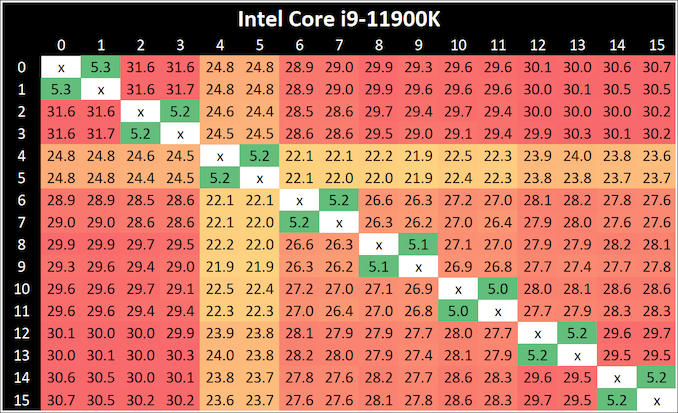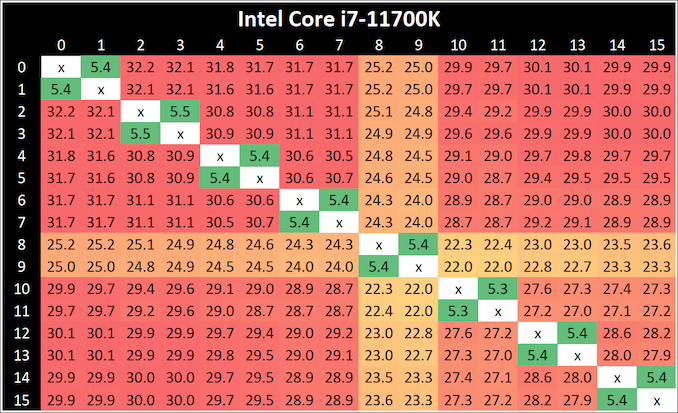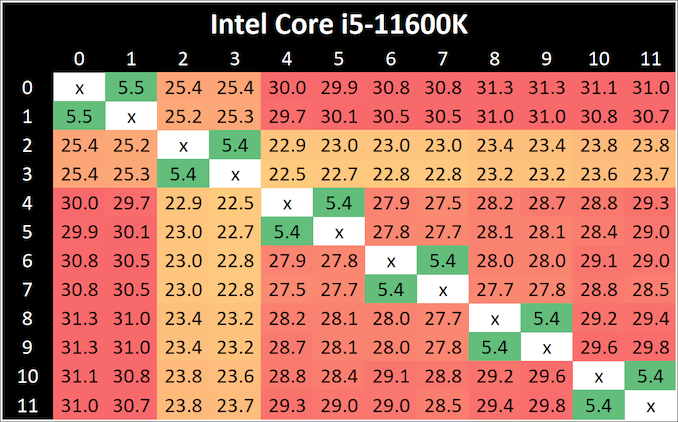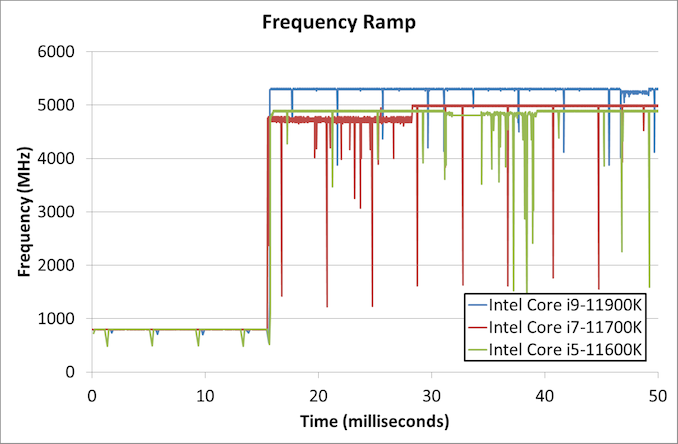Intel Rocket Lake (14nm) Review: Core i9-11900K, Core i7-11700K, and Core i5-11600K
by Dr. Ian Cutress on March 30, 2021 10:03 AM EST- Posted in
- CPUs
- Intel
- LGA1200
- 11th Gen
- Rocket Lake
- Z590
- B560
- Core i9-11900K
CPU Tests: Microbenchmarks
Core-to-Core Latency
As the core count of modern CPUs is growing, we are reaching a time when the time to access each core from a different core is no longer a constant. Even before the advent of heterogeneous SoC designs, processors built on large rings or meshes can have different latencies to access the nearest core compared to the furthest core. This rings true especially in multi-socket server environments.
But modern CPUs, even desktop and consumer CPUs, can have variable access latency to get to another core. For example, in the first generation Threadripper CPUs, we had four chips on the package, each with 8 threads, and each with a different core-to-core latency depending on if it was on-die or off-die. This gets more complex with products like Lakefield, which has two different communication buses depending on which core is talking to which.
If you are a regular reader of AnandTech’s CPU reviews, you will recognize our Core-to-Core latency test. It’s a great way to show exactly how groups of cores are laid out on the silicon. This is a custom in-house test built by Andrei, and we know there are competing tests out there, but we feel ours is the most accurate to how quick an access between two cores can happen.
All three CPUs exhibit the same behaviour - one core seems to be given high priority, while the rest are not.
Frequency Ramping
Both AMD and Intel over the past few years have introduced features to their processors that speed up the time from when a CPU moves from idle into a high powered state. The effect of this means that users can get peak performance quicker, but the biggest knock-on effect for this is with battery life in mobile devices, especially if a system can turbo up quick and turbo down quick, ensuring that it stays in the lowest and most efficient power state for as long as possible.
Intel’s technology is called SpeedShift, although SpeedShift was not enabled until Skylake.
One of the issues though with this technology is that sometimes the adjustments in frequency can be so fast, software cannot detect them. If the frequency is changing on the order of microseconds, but your software is only probing frequency in milliseconds (or seconds), then quick changes will be missed. Not only that, as an observer probing the frequency, you could be affecting the actual turbo performance. When the CPU is changing frequency, it essentially has to pause all compute while it aligns the frequency rate of the whole core.
We wrote an extensive review analysis piece on this, called ‘Reaching for Turbo: Aligning Perception with AMD’s Frequency Metrics’, due to an issue where users were not observing the peak turbo speeds for AMD’s processors.
We got around the issue by making the frequency probing the workload causing the turbo. The software is able to detect frequency adjustments on a microsecond scale, so we can see how well a system can get to those boost frequencies. Our Frequency Ramp tool has already been in use in a number of reviews.
From an idle frequency of 800 MHz, It takes ~16 ms for Intel to boost to the top frequency for both the i9 and the i5. The i7 was most of the way there, but took an addition 10 ms or so.














279 Comments
View All Comments
mitox0815 - Tuesday, April 13, 2021 - link
The development doesn't seem so special when you think about how extremely high-tech this market is...freshly entering it without special circumstances is nearly impossible. The entry barriers are crazy. So increasing market consolidation seems natural.TrueJessNarmo - Tuesday, March 30, 2021 - link
5600x abnormally topping the gaming charts.On gamers nexus charts on the other hand it was consistently below 5800x/5900x/5950x in gaming even though they clearly have strong bias towards 6 core budget CPU's in their recommendation.
Completely opposite picture. Why is that?
Hifihedgehog - Tuesday, March 30, 2021 - link
It may come down to the memory settings. Ian strictly follows JEDEC timings which all reviewers should.TrueJessNarmo - Tuesday, March 30, 2021 - link
Stock 5600x has lower clocks vs 5800x/5900x/5950x. It should be slower. Any other result is abnormal.Besides Gamers nexus is arguably the most trusted and the most accurate benchmarks in regards to gaming, CPU's and GPU's. You can read up on their test methodology here:
https://www.gamersnexus.net/guides/3577-cpu-test-m...
I suspect it has something to do with subtle insufficient power or cooling or both. Or perhaps they just have really great 5600x sample and really terrible 5800x/5900x samples.
BushLin - Tuesday, March 30, 2021 - link
They absolutely shouldn't if their audience is mostly buying decent ram and enabling XMP. I would argue that people reading anandtech deserve to see what a platform can reasonably deliver rather than castrated pre-built systems. DDR4-3600 isn't expensive or unstable for modern platforms.Hifihedgehog - Tuesday, March 30, 2021 - link
I realize this, but AnandTech is in the interesting position of appealing to both enthusiasts and professionals so using JEDEC is an effort to give a nod to the professional side of the audience... presumably, at least. Nonetheless, I agree: I have always used XMP/DOHC settings since day 1 of Ryzen as much as possible so it would be nice to see the performance with faster RAM settingsOxford Guy - Wednesday, March 31, 2021 - link
' Ian strictly follows JEDEC timings which all reviewers should.'BS. Motherboard makers even put out lists of supported XML RAM sticks.
They try to have their cake and eat it, to justify their kneecapping of Zen 1 and 2.
• Extremely high CFM coolers, with no decibel level information
• Allowing boards to bypass the supposed Intel standard for turbo
No, sorry... they're trying to make Intel look and sound good because they want to retain early access. It's part of the devil's bargain the tech press has to follow. Either pay the piper by posting a lot of awful spin and tricky tactics or be excluded and lose all those clicks to others.
Qasar - Wednesday, March 31, 2021 - link
here is a thought, if you think AT is doing such a crappy job with their testing methodology, go make your OWN review site, and review products how think it should be done, problem solvedOxford Guy - Thursday, April 1, 2021 - link
It’s not a particularly original nor useful thought. Feedback from customers is valued by most businesses.Qasar - Thursday, April 1, 2021 - link
not when they sound more like whinning and complaining